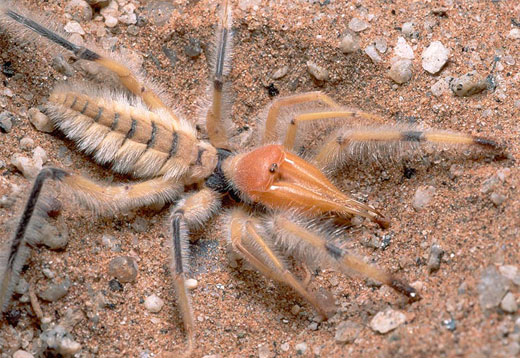|
Camel Spiders |
||||
| Camel Spiders Home | Camel Myths | Camel Spiders FAQ | Camel Spider Humor | Camel Spider Videos |
Camel spiders mythsAs many people so many thoughts, may be that's why people sometimes imagine so unreal situations and as a result they create so many unbelievable myths. So, the first one: "In the deserts of the Near East, there are "camel spiders" that anaesthetize sleeping humans and eat large chunks of their flesh."This legend is widespread in Arab countries but also was unknown in North America until it was disseminated by Gulf War veterans and repeated by the uninformed narrator of a TV documentary. Since this section was originally written, a much more extensive body of "camel spider" legends has arisen from the Iraq war. A number of soldiers have written claiming this legend is really true. But no one has been able to supply the name, rank and serial number of any victim - or even just a name! It always happened to "a friend," the friend never has a name, and no matter how far down the line you follow the story, that elusive named person is always at least one "friend" away. That's how urban legends work. Also rather popular myth with people: "Camel spiders" in Iraq are a foot long, lay eggs under camels' skin, and run 25 miles per hour screaming like a banshee.Of course they are fast, but not that fast. The maximum speed which was cited in scientific sources is ten miles per hour. They are not known for jumping ability. The species in Iraq were studied in Iraq by British scientists during the 39 years (1919-58) the country was under British control. Their anatomy and physiology are well known. They positively have no venom, and no way to inject it even if they did have it. They lay their eggs in the soil, not in camels! They are predatory and do not feed off large animals like camels or humans. When they run toward someone standing in the hot desert sun they are just seeking for a shade to hide in. Some species can produce a barely audible stridulation (sounding like a buzz or hiss). One more: "Spiders can lay their eggs under human skin in wounds created by their bites."In a surprisingly widespread urban legend, a nameless woman is bitten by a spider (usually on her cheek) while on vacation. She later develops a swelling from which baby spiders emerge Somehow or other, the venom must have transformed into eggs. You should remember that spiders do not find the human body a suitable site for egglaying, and no actual case anything like this can be found anywhere in scientific or medical literature. And may be the most favorite one: "Camel spiders can be as large as a frisbee."The size of a camel spider is nearly up to 6 inches although there're a lot of people report mch larger. "Camel spiders venom is an anesthetic that numbs their prey"It's really important to remember that spiders don't have venom at all, so they're not dangerous for people. It's obviously that they can bite but only in case of self defense. Despite their fearsome appearance and their strong bite, solifugids are unlikely to harm humans. In the past they were considered venomous and extremely dangerous but it is now thought that the only risk of injury resulting from them is caused by shock or infection following a bite. So, now you may see that all these myths don't have any factual background and they shouldn't be believed in.  |
| Copyright © www.camel-spiders.net |